Sichuan Opera
Sichuan Opera: A Vibrant Cultural Gem of China
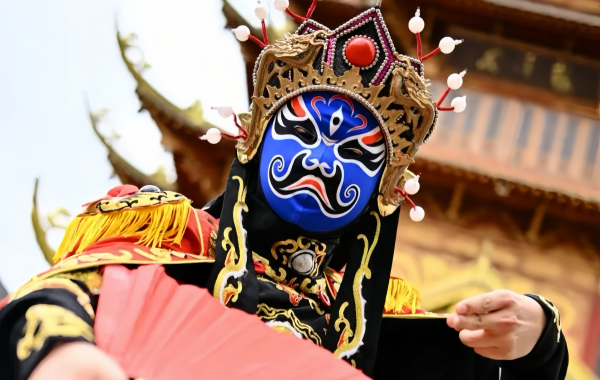
Sichuan Opera, also known as Chuan Ju in Chinese, is one of the oldest and most distinctive traditional Chinese operas, with a rich history and a unique artistic charm. It originated in the Sichuan Basin and has gradually developed into a comprehensive art form that combines singing, recitation, acting, and acrobatics. Sichuan Opera is renowned for its lively performances, colorful costumes, and a wide range of facial makeup patterns, which vividly depict various characters and emotions. It serves as a window into the cultural heritage of Southwest China, reflecting the local people's way of life, values, and aesthetic preferences.
 History of Sichuan Opera
History of Sichuan Opera
A. Early Origins
The roots of Sichuan Opera can be traced back to the Tang Dynasty (618 - 907 AD). During this period, a form of popular entertainment called "paramita songs" emerged in Sichuan. These songs were often performed at festivals and gatherings, and they laid the foundation for the development of Sichuan Opera's musical style. The lyrics were usually simple and easy to understand, reflecting the daily lives of the common people.
In the Song Dynasty (960 - 1279 AD), "Zaju," a type of dramatic performance, became popular in Sichuan. Zaju combined singing, dancing, and comic skits, and it introduced more complex storylines and character development. This was a significant step in the evolution of Sichuan Opera, as it began to incorporate elements of drama into its performances.
B. Ming and Qing Dynasties
During the Ming (1368 - 1644 AD) and Qing (1644 - 1912 AD) dynasties, Sichuan Opera experienced a period of rapid development. Various local operatic forms in Sichuan, such as "Gaoqiang," "Huqin," and "Lantern Opera," began to merge and exchange artistic elements. This cross - pollination led to the formation of a more unified and mature Sichuan Opera style.
In the late Qing Dynasty, Sichuan Opera troupes became more organized, and professional training systems were established. Many famous actors emerged during this time, and their performances attracted large audiences across the region. Sichuan Opera also started to spread to neighboring provinces, further expanding its influence.
C. Modern Era
In the 20th century, especially after the founding of the People's Republic of China in 1949, Sichuan Opera underwent significant reforms. The government supported the development of Sichuan Opera by establishing professional opera troupes, training new talents, and promoting traditional repertoire. New plays were created to reflect contemporary social themes, and traditional plays were adapted to meet the aesthetic needs of modern audiences.
In recent decades, with the increasing globalization of culture, Sichuan Opera has also stepped onto the international stage. It has been performed in many countries around the world, introducing Chinese culture to a global audience and gaining international recognition.
 Distribution Areas of Sichuan Opera
Distribution Areas of Sichuan Opera
A. Provinces
1. Sichuan Province: As the birthplace of Sichuan Opera, Sichuan is undoubtedly the center of its distribution. Major cities such as Chengdu, Chongqing (which was once part of Sichuan and still has a strong Sichuan Opera tradition), Zigong, and Leshan have numerous professional and amateur Sichuan Opera troupes. These troupes perform regularly in theaters, temples, and community centers, attracting both local residents and tourists.
2. Guizhou Province: Due to its geographical proximity to Sichuan, Guizhou has also been influenced by Sichuan Opera. In cities like Guiyang and Zunyi, Sichuan Opera performances are not uncommon, and some local troupes have even incorporated elements of Guizhou's ethnic cultures into their shows, creating a unique fusion style.
3. Yunnan Province: Similar to Guizhou, Yunnan shares cultural similarities with Sichuan. In Kunming and other major cities in Yunnan, Sichuan Opera has a certain number of fans. Some Yunnan - based opera troupes also perform Sichuan Opera classics, contributing to the spread and preservation of this art form in the region.
B. Scenic Spots and Museums
1. Shu Feng Ya Yun Sichuan Opera Theater in Chengdu: This is one of the most famous Sichuan Opera theaters in Chengdu. Located in a traditional Sichuan - style building, the theater offers regular performances that showcase the best of Sichuan Opera. Visitors can not only watch the performances but also learn about the history and culture of Sichuan Opera through exhibitions and interactive activities.
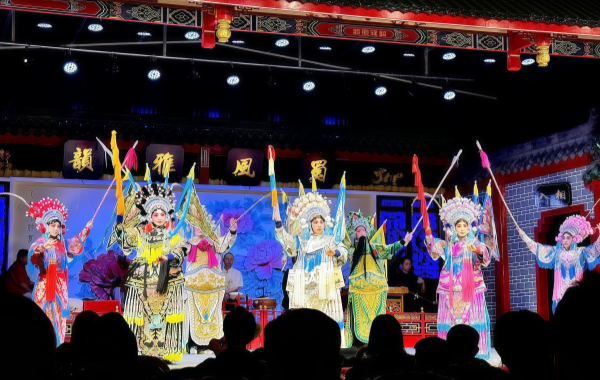
2. Sichuan Opera Museum in Chengdu: The museum is dedicated to the preservation and promotion of Sichuan Opera. It houses a large collection of costumes, props, facial makeup patterns, and historical documents related to Sichuan Opera. Through multimedia displays and guided tours, visitors can gain a in - depth understanding of the development of Sichuan Opera over the centuries.
3. Jinli Ancient Street in Chengdu: Jinli is a popular tourist destination that recreates the atmosphere of ancient Chengdu. Along the street, there are often street performances of Sichuan Opera snippets, allowing visitors to experience the charm of this art form in a more casual and lively setting.
 Features and Unique Skills of Sichuan Opera
Features and Unique Skills of Sichuan Opera
A. Singing Styles
Sichuan Opera has a diverse range of singing styles, each with its own characteristics. The "Gaoqiang" style is known for its high - pitched and melodious tunes, often used to express strong emotions such as joy, anger, or sorrow. The "Huqin" style, on the other hand, has a more gentle and lyrical quality, suitable for depicting romantic or sentimental scenes. The combination of these different singing styles adds richness and variety to Sichuan Opera performances.
B. Comic Skits and Witty Dialogues
Humor is an important element of Sichuan Opera. Many plays incorporate comic skits and witty dialogues, which not only entertain the audience but also often convey social satire and moral lessons. The actors' clever wordplay and exaggerated performances can always elicit laughter from the audience, making Sichuan Opera a highly engaging and enjoyable art form.
C. Unique Acrobatic Skills
1. Face - Changing (Bian Lian): This is perhaps the most well - known and spectacular skill in Sichuan Opera. Actors can change their facial makeup instantly, sometimes within a fraction of a second, to show different emotions or character transformations. The secret of face - changing is closely guarded within the Sichuan Opera community, and it requires years of practice and skill to master. There are several methods of face - changing, including the "wiping" method, where the actor uses a special oil - based makeup and wipes it with a cloth to change the color; the "blowing" method, where powder is blown onto the face to create a new look; and the "pulling" method, where thin silk masks are attached to the face and pulled off to reveal a different face.
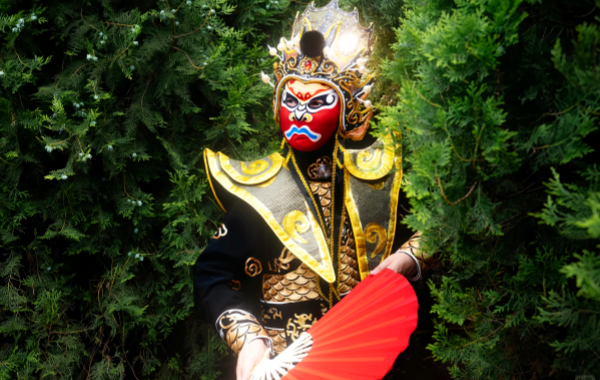
2. Fire - Spitting (Tu Huo): Another thrilling skill in Sichuan Opera is fire - spitting. Actors can spit out a stream of fire from their mouths, creating a dramatic and eye - catching effect. This skill requires precise control of breath and the use of special fuel, and it is often used in scenes of combat or supernatural events to enhance the atmosphere.
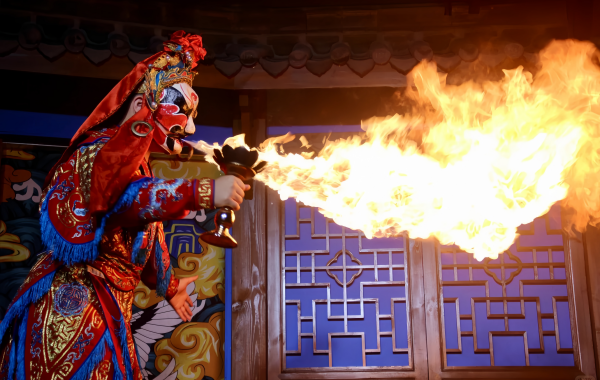
3. Somersaulting and Acrobatics: Sichuan Opera also incorporates a variety of somersaulting and acrobatic skills. Actors can perform high - flying flips, splits, and other difficult stunts, adding a dynamic and physical element to the performances. These acrobatic skills are often used to depict action - packed scenes such as battles or chases.
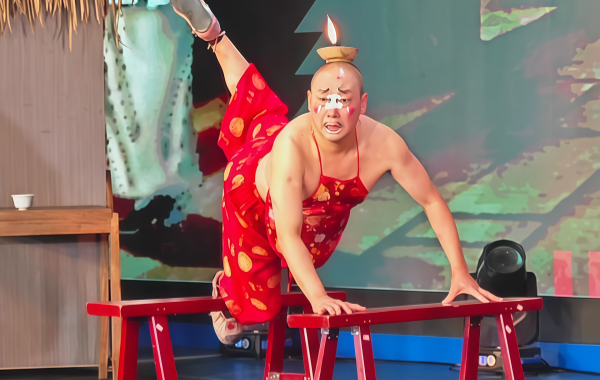
 Costumes, Facial Makeup, and Appearance in Sichuan Opera
Costumes, Facial Makeup, and Appearance in Sichuan Opera
A. Costumes
1. Design and Materials: Sichuan Opera costumes are richly designed and made from high - quality materials such as silk, brocade, and satin. The costumes are often brightly colored, with intricate patterns and embroidery that reflect the character's identity, status, and personality. For example, emperors and nobles usually wear costumes with golden threads and dragon patterns, while common people wear simpler and more plain - colored clothes.
2. Types of Costumes: There are different types of costumes for different roles in Sichuan Opera. The "Sheng" (male roles) costumes include the "Wusheng" (martial male) costume, which is designed for action - oriented characters and usually has short sleeves and a tight - fitting design for ease of movement; and the "Wensheng" (civilian male) costume, which is more elegant and formal, often with long robes and wide sleeves. The "Dan" (female roles) costumes are also diverse, ranging from the delicate and ornate "Hua Dan" (young female) costume to the solemn and dignified "Zheng Dan" (mature female) costume. The "Jing" (painted - face male) and "Chou" (clown) roles also have their own distinctive costumes that help to define their characters.
B. Facial Makeup
1. Symbolism and Meanings: Facial makeup in Sichuan Opera is highly symbolic. Different colors and patterns are used to represent different character traits and emotions. For example, red usually represents loyalty and bravery, such as in the case of Guan Yu, a famous historical figure in Chinese history; black represents integrity and impartiality, like Bao Zheng, a well - known upright official; white represents cunning and treachery, as seen in the character of Cao Cao, a wily politician in ancient China.
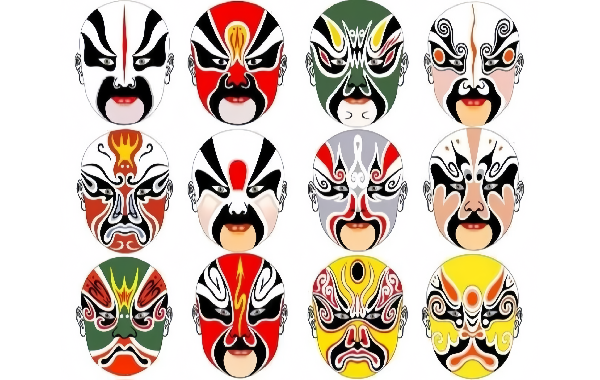
2. Patterns and Styles: There are various facial makeup patterns in Sichuan Opera, each with its own unique design. The "Sankuai Wa" (three - piece face) is a common pattern, where the face is divided into three parts with different colors and designs. The "Huaban Wa" (flower - piece face) is more complex, with intricate floral patterns painted on the face, often used for female or supernatural characters. The "Xiezi Wa" (slanting - eye face) is characterized by slanted eyes and a fierce expression, usually used for villainous or warrior characters.
C. Appearance and Hairstyles
In addition to costumes and facial makeup, hairstyles also play an important role in defining a character's appearance in Sichuan Opera. Female characters often have elaborate hairstyles with hairpins, flowers, and other ornaments, which vary depending on their age, status, and the period in which the story is set. Male characters' hairstyles are relatively simpler, but they also reflect their roles and personalities. For example, a scholar might have a neat and refined hairstyle, while a warrior might have a more rugged and practical one.
 How to Experience Sichuan Opera for Foreigners
How to Experience Sichuan Opera for Foreigners
A. Watching Performances in Theaters
1. Choosing a Theater: For foreigners visiting China, especially Sichuan Province, watching a Sichuan Opera performance in a professional theater is a must - do experience. As mentioned earlier, the Shu Feng Ya Yun Sichuan Opera Theater in Chengdu is a great choice. It offers high - quality performances with English subtitles or audio guides in some cases, making it easier for foreign audiences to understand the plot and appreciate the art form.
2. Booking Tickets: Tickets for Sichuan Opera performances can usually be booked online through official theater websites or third - party ticketing platforms. It is advisable to book tickets in advance, especially during peak tourist seasons, to ensure a good seat. Some theaters also offer group discounts and special packages that include dinner or a guided tour before the performance.
3. Pre - performance Preparation: Before watching the performance, it is helpful to do some research on Sichuan Opera. You can read about the basic elements of the opera, such as the different roles, singing styles, and unique skills. This will enhance your understanding and appreciation of the performance. You can also watch some short video clips of Sichuan Opera online to get a sense of what to expect.
B. Participating in Workshops and Cultural Activities
1. Finding Workshops: Many cultural institutions, museums, and tourism companies in Sichuan offer Sichuan Opera workshops for foreigners. These workshops provide an opportunity to learn about the basic skills of Sichuan Opera, such as simple facial makeup application, basic singing techniques, and some acrobatic movements. The workshops are usually led by experienced Sichuan Opera actors or teachers who can provide guidance and feedback.
2. Duration and Content: The duration of the workshops can vary from a few hours to a whole day, depending on the program. During the workshop, you will learn about the history and culture of Sichuan Opera, try on costumes, and even have a chance to perform a short scene under the guidance of the instructor. This hands - on experience will give you a deeper understanding of the art form and create unforgettable memories.
C. Exploring Sichuan Opera - related Scenic Spots
1. Visiting Museums and Exhibitions: As mentioned earlier, the Sichuan Opera Museum in Chengdu is a great place to learn about the history and development of Sichuan Opera. The museum has a rich collection of artifacts, including costumes, props, and historical documents. You can take a guided tour to learn about the stories behind these exhibits and gain a comprehensive understanding of Sichuan Opera culture.
2. Strolling through Ancient Streets: Jinli Ancient Street in Chengdu is not only a beautiful place to experience traditional Sichuan architecture and cuisine but also a great spot to catch some street performances of Sichuan Opera. Walking along the street, you can stop and watch these short performances, interact with the actors, and take photos. This casual and immersive experience allows you to feel the vibrant atmosphere of Sichuan Opera in a real - life setting.
D. Interacting with Local Artists and Enthusiasts
1. Joining Local Cultural Events Through Intotravelchina: In Sichuan, there are often local cultural events and festivals that feature Sichuan Opera performances. By participating in these events, you can meet local Sichuan Opera artists and enthusiasts. You can chat with them, ask questions, and learn about their experiences and insights into the art form. This kind of interaction will give you a more authentic and in - depth understanding of Sichuan Opera.
2. Using Social Media and Online Communities: If you are interested in Sichuan Opera but are not currently in China, you can still connect with Sichuan Opera fans and artists through social media and online communities. There are many Facebook groups, WeChat public accounts, and YouTube channels dedicated to Sichuan Opera. You can join these communities, share your thoughts, and learn from others. Some artists may even offer online classes or Q&A sessions, allowing you to learn about Sichuan Opera from the comfort of your own home.
What Our Clients Say?
Based on 10,000+ traveler reviews











